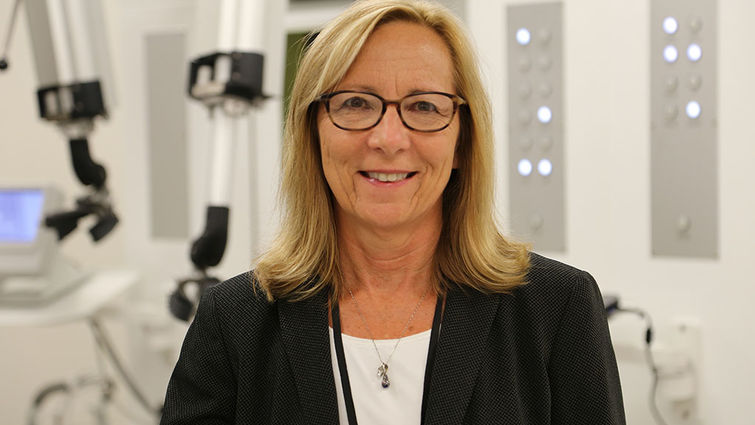
Barbara Holshouser, PhD, is the director of the new Center for Imaging Research that recently opened on the campus of Loma Linda University Health.
The Center for Imaging Research recently opened at Loma Linda University School of Medicine to enable Inland Empire physicians to employ new and very promising diagnostic and treatment tools in the war on cancer and other diseases.
According to Barbara Holshouser, PhD, director of the center, the new tools, called radiopharmaceuticals, hail from the fields of molecular imaging and precision medicine.
Described as isotopes incorporated into small molecules and delivered to the site of the offending cancer cells, radiopharmaceuticals are useful for two important functions: they either target the disease with very precise doses of radiation designed to kill it, or image various structures of the body very precisely.
Mark Reeves, MD, PhD, director of the Loma Linda University Cancer Center, is enthusiastic about new treatment and diagnostic options molecular imaging brings to patient care.
“This center takes personalized therapy to the next level,” Reeves observes. “It allows us to use imaging techniques to predict whether targeted therapies will work in individual patients. For example, in the field of cancer medicine, it will allow us to change treatments based on imaging as cancer cells mutate and change.”
The field of personalized medicine he references will allow physicians to employ a variety of diagnostic tests, including some that evaluate information gleaned from patients’ individual DNA profiles, in order to determine which treatments or prevention plans will work best for a given individual patient.
Holshouser says the center benefits from a partnership between the university and PETNET Solutions, Inc., a wholly-owned subsidiary of Siemens Medical Solutions, Inc.
“PETNET has more radiopharmacy facilities than any other company in the world,” she observes. “They operate one here under their license and the university leases the space to them.”
A major function of the center is the production of radioactive compounds using the two cyclotrons that have been operational here since 2015. The main compound produced at the PETNET facility is 18-F FDG, using the Fluorine 18 positron-emitting nuclide tagged to fluorodeoxyglucose.
“18-F FDG is used to detect cancer,” Holshouser notes. “It is the most commonly-used radiopharmaceutical agent. All clinical PET centers use it.”
The main drawback to 18-F FDG is its short half-life of approximately 110 minutes. That means that the compounds must be used shortly after they are made. Having cyclotrons here on campus means that 18-F FDG can be produced, transported, and used before it decays away.
Penelope Duerksen-Hughes, PhD, associate dean and professor of basic sciences at LLU School of Medicine, points out that in addition to standard radioisotopes like 18-F FDG, the center can also manufacture a number of other, more unique isotopes, such as Carbon-11, with even shorter half-lives.
“This vastly increases the number of options available,” Duerksen-Hughes explains, “and represents something that can only be done in places that have cyclotrons, like Loma Linda University Health. We are anticipating that these capabilities will attract a significant number of new clinical trials. That is really where the rubber will meet the road when it comes to improving patient health.”
Holshouser and radiochemist Umesh Gangadharmath, PhD, both from the department of radiology, are the two principals of the center. In addition to the cyclotrons, it involves a radiochemistry laboratory, and a pre-existing animal imaging facility. “The animal imaging facility has an MRI scanner and we’re in the process of refurbishing a micro CT and micro PET scanner for animals, that will be available for use by researchers in the center also,” she adds. The facility can produce radiopharmaceuticals for human as well as animal use.
“We have both imaging and production capabilities, so we can work with pharmaceutical companies interested in producing new radiopharmaceuticals at our center that can be tested in clinical trials in collaboration with our clinical researchers,” Holshouser continues. “The facility will be very capable. At this point, we see it operating as a core facility for students, researchers and physicians. We want to attract government and private funding grants for research.”
Duerksen-Hughes says the center reaches across multiple entities of Loma Linda University Health.
“The center is located within the School of Medicine,” Duerksen-Hughes reports, “and has an oversight board chaired by David B. Hinshaw, Jr., MD, the chair of radiology.” Duerksen-Hughes, who is also a member of that board, says the center will report to both radiology and basic sciences.
